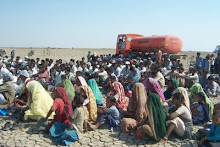Maulik Pathak; Business Standard; August 05, 2009,
Mumbai-Ahmedabad; Fate of over 45,000 agariyas or self employed traditional salt pan workers in the proposed Wild Ass Sancutary area in Little Rann of Kutch hangs fire as the settlement officer (additional collector) has turned down their 'customary rights'.
As per the report by settlement officer, 2398 claims of salt pan-workers were verified by settlement officer, of which 397 have been approved.
The small and marginal salt pan workers in Little Rann produce over 30 per cent of the country's total production of salt and most of the inland salt production of the state. Gujarat produces close to 150 lakh tonnes of salt annually which is about 70 per cent of the country's production.
The Industries Commissioner has in its reply to an Right To Information (RTI) application filed by trade union Agariya Heetrakshak Sangh, said that there are around 48,000 salt-pan workers in Little Rann of Kutch. Gujarat has close to 1.04 salt pan workers.
Covering about 5000 sq km of area and spread in Patan, Surendranagar, Rajkot and Kutch district, Little Rann of Kutch had been notified by the state government under Wild Bird and Wild Animal Protection Act in 1973 and the Act was later repeled in 2004.
Bharat Devsinh Patadia, a salt pan worker from Ajitgadh said, "So far we have not been forced out of the sanctuary area, however the officials have told us to leave on our own."
Also, from last many years the lease of salt-pan workers has not been renewed.
"There are close to 10-12 thousand families or over 40,000 salt pan workers in the area. Each family can produce an average of 500-600 tonnes annually from one pan. The 'agariyas' have been into salt harvesting for over 300-400 years. This is the community's livelihood since ages. Where can we go now?" said Thakkersinh Dharamsinh Mahaliya, a salt pan worker from Himmatpura in Surendranagar district.
The season for salt harvesting is from September to June when over 10,000 agariya families wade three kilometers deep in the deserts in search of livelihood. A worker earns about Rs 140 per tonne of salt.
"The government has stopped renewing or issuing new leases to salt pan workers from last ten years. Since some companies cannot buy directly from the workers in Little Rann, they buy it through traders and contractors," said Jeetu Zala, member of Kuda Agar Kamdar Mahamandal.
The government had entered into long-term lease agreement with some big players hence their activity is not considered illegal, said another worker.
According to Bheemani Jaresa, an agariya community leader, "Although some measures like a mobile ration shop and potable water supply through tankers are being initiated, these are certainly not enough. Our demand is that the government must introduce a minimum support price for the salt produced by us on the same lines as given to farmers for agricultural produce."
Despite growing demand from chemical industry, the salt pan workers had to face a brunt of rising fuel prices and excessive rains in last two years.
Mumbai-Ahmedabad; Fate of over 45,000 agariyas or self employed traditional salt pan workers in the proposed Wild Ass Sancutary area in Little Rann of Kutch hangs fire as the settlement officer (additional collector) has turned down their 'customary rights'.
As per the report by settlement officer, 2398 claims of salt pan-workers were verified by settlement officer, of which 397 have been approved.
The small and marginal salt pan workers in Little Rann produce over 30 per cent of the country's total production of salt and most of the inland salt production of the state. Gujarat produces close to 150 lakh tonnes of salt annually which is about 70 per cent of the country's production.
The Industries Commissioner has in its reply to an Right To Information (RTI) application filed by trade union Agariya Heetrakshak Sangh, said that there are around 48,000 salt-pan workers in Little Rann of Kutch. Gujarat has close to 1.04 salt pan workers.
Covering about 5000 sq km of area and spread in Patan, Surendranagar, Rajkot and Kutch district, Little Rann of Kutch had been notified by the state government under Wild Bird and Wild Animal Protection Act in 1973 and the Act was later repeled in 2004.
Bharat Devsinh Patadia, a salt pan worker from Ajitgadh said, "So far we have not been forced out of the sanctuary area, however the officials have told us to leave on our own."
Also, from last many years the lease of salt-pan workers has not been renewed.
"There are close to 10-12 thousand families or over 40,000 salt pan workers in the area. Each family can produce an average of 500-600 tonnes annually from one pan. The 'agariyas' have been into salt harvesting for over 300-400 years. This is the community's livelihood since ages. Where can we go now?" said Thakkersinh Dharamsinh Mahaliya, a salt pan worker from Himmatpura in Surendranagar district.
The season for salt harvesting is from September to June when over 10,000 agariya families wade three kilometers deep in the deserts in search of livelihood. A worker earns about Rs 140 per tonne of salt.
"The government has stopped renewing or issuing new leases to salt pan workers from last ten years. Since some companies cannot buy directly from the workers in Little Rann, they buy it through traders and contractors," said Jeetu Zala, member of Kuda Agar Kamdar Mahamandal.
The government had entered into long-term lease agreement with some big players hence their activity is not considered illegal, said another worker.
According to Bheemani Jaresa, an agariya community leader, "Although some measures like a mobile ration shop and potable water supply through tankers are being initiated, these are certainly not enough. Our demand is that the government must introduce a minimum support price for the salt produced by us on the same lines as given to farmers for agricultural produce."
Despite growing demand from chemical industry, the salt pan workers had to face a brunt of rising fuel prices and excessive rains in last two years.
















.jpg)
.jpg)
.jpg)
.jpg)













No comments:
Post a Comment